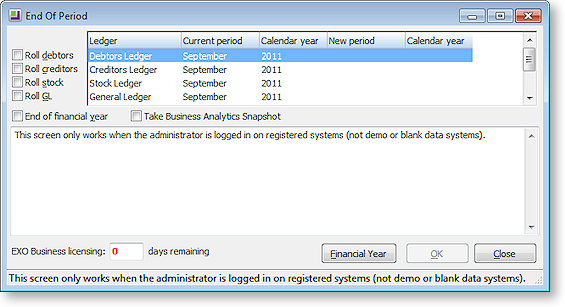End of Period/Year
Utilities > End of Period

MYOB EXO Business has a definite "end of period" or "roll-over" procedure. This process does the following:
- Sets period totals
- Sets month totals
- Copies aged balances to last period balances
- Sets aged balances
- Increments the transaction age
- Increments the allocation age
- Updates the allocation statuses
- Sets the closing rates for all currencies
- Ages the period status
- Rolls the period status
Each ledger (Debtors, Creditors, Stock and General Ledger) can be rolled separately or all ledgers can be rolled simultaneously (recommended). Tick the required boxes, then click OK to roll the selected ledgers.
Ticking the End of financial year box means that the End of Year procedure will be run as well as the End of Period procedure. The additional steps taken in an End of Year procedure are discussed below.
Ticking the Take Business Analytics Snapshot means that a snapshot is taken for the EXO Business Analytics module as part of the end of period process. This ensures that the final day’s trading is always completely captured.
Rolling the Debtors Ledger
Normal sequence of events:
-
Back up your database (you might want to keep this backup long term).
-
Finish entering all transactions for the period and the financial year.
-
Print and save all required Debtor reports (especially any involving year to date totals etc).
-
Print Debtors statements.
-
Post all Debtor transactions to the General Ledger (Utilities > Ledger Postings > Post Ledgers to GL).
-
Run the End of Period utility.
Extra steps performed in an End of Year procedure:
- Copies the This Year total to the Last Year total on all Debtor accounts.
- Zeros the This Year totals on all Debtor accounts.
Rolling the Creditors Ledger
Normal sequence of events:
-
Finish entering all transactions for the period and financial year.
-
Print and save all required Creditor reports (especially any involving year to date totals etc).
-
Print remittance advices, etc.
-
Post all Creditor transactions to the General Ledger (Utilities > Ledger Postings > Post Ledgers to GL).
-
Run the End of Period utility.
Extra steps performed in an End of Year procedure:
- Copies the This Year total to the Last Year total on all Creditor accounts.
- Zeros the This Year totals on all Creditor accounts.
Rolling the Stock Ledger
Normal sequence of events:
-
Finish entering all Debtor invoicing and Stock receipts for the period and financial year.
-
It is normal to run a stock take just prior to the End of Year, to ensure your closing stock valuation figures are as accurate as possible.
-
Print and save any required Stock reports such as Stock Valuation and Stock Sales reports.
-
Run the End of Period utility.
Extra steps performed in an End of Year procedure:
- Copies the This Year totals to the Last Year total on all Stock items.
- Zeros the This Year totals on all Stock items.
Rolling the General Ledger
Normal sequence of events:
-
Finish entering as many transactions for the period and financial year as you can. Even after the roll over you can post to prior years’ periods.
-
Extract and Post all transactions for the period and year from the Debtors and Creditors ledgers (Utilities > Ledger Postings > Post Ledgers to GL).
-
Print and save all required General Ledger reports (Balance Sheet, Profit & Loss etc)
-
Run the End of Period utility.
Extra steps performed in an End of Year procedure:
- Zeros off the Profit & Loss accounts and posts the resulting Profit or Loss to the retained earnings account as defined in the GL Control account screen.
- The Profit & Loss current year movements are cleared.
Note: The General Ledger has the capability of multiple open periods – even periods in past financial years. The system will detect whenever a GL Batch is entered into a period of a past financial year and prompt you as to whether it should update the previous year’s P/L figure. (You should normally agree to update this, to prevent the Balance Sheet from going out of balance.) You can continue to enter transactions for the past year after you have rolled the End of Year, and revised Profit & Loss and Balance sheets can be printed.
Points to Note
-
An End of Period must be performed before any transactions can be entered into the new period.
-
It is not necessary that all transactions be posted to General Ledger before a ledger is rolled over.
-
Complete specialised procedures like Exchange Rate Variance calculations before doing an End of Period.
-
There is no loss of transaction detail as a result of the End of Period or End of Year procedures. Transaction details are retained as history and are never automatically deleted by EXO Business.
-
Processes and controls exist to allow transactions to be posted back into prior periods. Period lock controls help manage this process, and periods would normally be locked once period reporting has been completed.
-
The Post to Past Period User-level profile setting must be enabled to allow users to post transactions on previous or past periods.
-
The Allow end of period rollover User-level profile setting must be enabled to allow a user to roll the end of period.
-
A Company-level profile setting called Enable warning for transactions not posted to GL before end of period processing can be enabled to prompt users if Post Debtors/Creditors/Stock to GL has not been processed yet an attempting to do an end of period.
Note: See the "Period Handling and Transaction Ageing" white paper for more detail.


